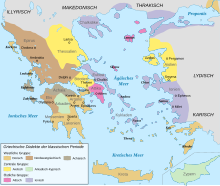Dorians
The Dorians (more rarely: Dorians ; ancient Greek Δωριεῖς Dōrieĩs ) were, in addition to the Achaeans , Ionians and Aiolers, an Indo-European , ancient Greek- speaking population that probably originally lived in north-western Greece ( Epirus ) and Macedonia . It is still a matter of dispute whether Dorians originally lived in the Dalmatian - Albanian region ( Illyria ).
Greece in Mycenaean times
For the Mycenaean period (approx. 1600 to 1050 BC) the Dorians in the Peloponnese and central Greece cannot yet be proven archaeologically. Even the Greek language on the Linear B tablets in the Mycenaean palace archives in Pylos , Mycenae , Knossos and Thebes does not yet show any traces of the Doric dialect. Since the Doric dialect was spoken mainly in the Peloponnese, on Crete , the southern Aegean Islands and the Greek settlements of Southwest Asia Minor , the majority of research assumes that the Dorians have migrated to these regions in the meantime.

Doric migration
For a time, some research assumed that the Dorians lived around 1200 BC. They migrated to central and southern Greece and from there via Crete to Kos, Rhodes and finally south-west Asia Minor. In their advance they would have conquered the Mycenaean palace centers and put an end to the Mycenaean culture . It was believed that they acted as destroyers on their journey through Greece.
However, in the last few decades it has become increasingly clear that the Mycenaean culture, despite some upheavals at the beginning of the 12th century, continued until around 1050/1000 BC. Has existed without major cultural breaks. It is true that shortly after 1200 BC. The palace economy system together and most of the previously known upper cities of the Mycenaean centers are destroyed; however, unless they have been completely abandoned , like the Mycenaean Pylos , they remain inhabited by apparently the same population. The pottery and other artifacts of the 12th and 11th centuries BC BC are clearly a continuation of the Mycenaean culture. In addition, apart from rough clay pots, so-called “hand-made ceramics”, in some places there are hardly any innovations and at best little that is strange. The previously widespread theory of a massive and violent Doric migration around 1200 BC Therefore, since the 1970s, specialist circles have met with increasing skepticism and rejection.
Many experts therefore assume that the Dorians immigrated in several batches around 1000 BC. Chr. It does not necessarily have to have been violent, at least not everywhere. From that time comes increasingly cremation and in the vase painting of the transition from the so-called carried submykenischen the so-called proto Geometric pottery .
Sparta and Colonies
In the 8th century BC Large parts of the Peloponnese (except Arcadia ), north-west Greece, Crete, Rhodes and south-west Asia Minor are Doric. From the 2nd half of the 8th century BC BC Doric cities took part in the colonization of southern Italy and Sicily.
A historically important polis ( Sparta ) formed the Dorians in the Peloponnese. In addition to Athens , it was able to develop into a hegemonic power in ancient Greece at times .
See also
Individual evidence
- ^ Roger D. Woodard: Greek dialects. In: Roger D. Woodard (Ed.): The Ancient Languages of Europe. Cambridge University Press, Cambridge 2008, p. 51
- ↑ The Great Ploetz. Freiburg i. B. 2008, p. 161, 195. See also Uwe Walter : Participating in the Polis: Citizenship and Belonging in Archaic Greece. Franz Steiner Verlag, Stuttgart 1993, p. 152 (with further documents).